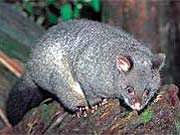
In the current crisis of global biodiversity loss, the discovery of new species is a welcome addition. But the recent finding that the mountain brushtail possum, an arboreal marsupial mammal of Australian wet forests, is actually made up of two species also poses new conservation challenges.
The new species is proposed in an article in the latest Australian Journal of Zoology (Volume 50, Issue 4), authored by Earthwatch-supported biologist Dr. David Lindenmayer (Australian National Universit

The basque company SK10, which works in the integration of aeronautical structures, has given a significant step forward in its innovation range within compound materials of carbon fibre.
Recently, SK10 has signed with the company EADS-CASA a contract for the development, industrialisation and subsequent mass production of the leading edges of the horizontal stabiliser for the new aircraft Falcon F7X, of the French company DASSAULT.
The development of horizontal stabiliser

The ophthalmology team of the University Clinic of the University of Navarre has published a new technique to detect diabetic retinopathy. This research has been published in the magazine Investigative Ophthamology and Visual Science. The research is based on the Optical Coherence Tomography (OCT). This test allows measuring the thickness of eye macula without touching the eye and without using contrast injection. The macula is the central part of the retina and is the responsible of the central vis

Subtle alterations of a hormonal stress response system called the HPA axis may play a role in chronic fatigue syndrome, according to a study in the November/December issue of Psychosomatic Medicine.
A smoothly functioning hypothalamus-pituitary-adrenal, or HPA, axis helps the body remain stable under physiological and psychological stress through the actions of three hormones. First, the brain portion called the hypothalamus secretes a hormone that stimulates the pituitary gland to secrete

VLT Images Intergalactic Shock The Universe is a violent place – as astronomers use increasingly sensitive means and methods to study the diverse processes out there, they become aware of the extraordinary forces acting in the space that surrounds us. With larger telescopes and ever-more sophisticated instruments, new information is gained about remote celestial objects and their behaviour. Among the most intriguing ones are the radio galaxies which emit prodiguous amounts of

Reducing the sulphur content of pollutants can have a substantial impact in reducing death from respiratory and cardiovascular diseases, conclude authors of a study in this week’s issue of THE LANCET which describes the effect of a public-health initiative in Hong Kong.
A change in law to restrict sulphur emissions was introduced in Hong Kong in July 1990; all power plants and road vehicles had to use fuel oil with a sulphur content restricted to not more than 0·5% by weight. This intervent

– new calculation confirms standard model of particle physics. Contribution of hadronic vacuum polarization determined with unprecedented accuracy. The magnetic moment of the muon is an important precision parameter for…
Technique may prevent formation of unwanted waves that siphon off needed energy. Heating plasma to the ultra-high temperatures needed for fusion reactions requires more than turning the dial on a…

An international team of astronomers, led by researchers from the Astronomical Observatory of the University of Warsaw, have identified a new class of cosmic X-ray sources. The findings have been…

Antibody that Neutralizes Inhibitory Factors Involved in Nerve Regeneration Leads to Enhanced Motor Function after Acute Spinal Cord Injury. Researchers at 13 clinics in Germany, Switzerland, the Czech Republic and…

How the body’s natural killer cells could fight leukemia. Every year, some 13,000 people in Germany are diagnosed with leukemia. Despite intensive chemotherapy, around one in two of them die….

… eco-friendly reactor converts air and water into ammonia. Producing enough ammonia to feed the world comes with a large carbon footprint;. process described in new UB-led study could help…

How simulations help manufacturing of modern displays. Modern materials must be recyclable and sustainable. Consumer electronics is no exception, with organic light-emitting diodes (OLEDs) taking over modern televisions and portable…

“Neurons that fire together, wire together” describes the neural plasticity seen in human brains, but neurons grown in a dish don’t seem to follow these rules. Neurons that are cultured…

The quest for sustainable energy solutions has been a major focus of scientific research for decades. Solar energy, a clean and renewable source, has emerged as a promising alternative to…

With a processing speed a billion times faster than nature, chip-based laser neuron could help advance AI tasks such as pattern recognition and sequence prediction. Researchers have developed a laser-based…

New technology could remotely identify various types of plastics, offering a valuable tool for future monitoring and analysis of oceanic plastic pollution. Researchers have developed a new hyperspectral Raman imaging…

Artificial Intelligence (AI) has established a strong presence across industries, large and small. The “VoBaKI” research project has empowered small and medium-sized enterprises (SMEs) with an innovative tool to independently…